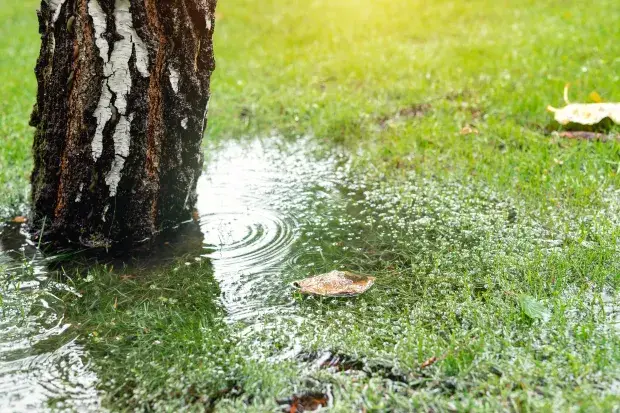Ways to Fix a Waterlogged Lawn
Last Updated on July 26, 2024 by Duncan
When your lawn is waterlogged, it not only damages the grass, making it look ugly, but it also increases the chances of moss and algae growing on your lawn.
Signs your lawn is waterlogged
Besides seeing water on your lawn, several things can tell you that it’s time to give some attention to your lawn. These things include:
Bare patches: As the grass dies, it leaves behind barren grass areas. These areas are more common in the most severely affected lawn areas.
Moss patches: While a moderate quantity of moss is helpful in a lawn, excessive amounts can cause the grass to die by stealing ground minerals.
Excess weeds: Weeds are prevalent in most lawns, but if you don’t get rid of them early enough, they can swiftly take over a weak lawn and starve the remaining grass of nutrition.
While there is nothing you can do to stop the rains, there are several things you can do to ensure that your lawn looks great despite the heavy rains. Some of the things you can do include:
Fix the drainage system.
You might think your lawn is waterlogged due to the heavy rains, but this isn’t always true.
If you feel your lawn is too wet compared to the rainfall, check the drainage system.
If you have a drainage problem, consider installing a French drain. You can also consult a professional to give another option to ensure your lawn remains as dry as possible.
Aerate the soil
Compacted soil is a primary cause of a soggy lawn. Over time, the soil on your lawn can take a hammering and become too compacted for water to permeate and flow through adequately. The compaction is severe in high-traffic areas near the walkways and gazebo.
When you aerate the soil, you rip holes through that tight, compact earth and allow it to breathe. This breaks up the tight layer of soil, allowing the grassroots to stretch out and absorb some of the water while allowing the remainder to flow through.
Aerating your lawn is simple, and you can’t go wrong even if you have never done it before. You don’t need any high-tech gadgets to get the job done; you only need a garden fork.
You can also buy some aerating shoes and walk around on your lawn.
For the best outcome, ensure that the holes are no more than six inches deep and allow water to access the roots without becoming excessively saturated.
Clear your lawn
Your lawn might be waterlogged because it’s too clogged up with debris. This calls for you to get rid of any debris that might be lying around your lawn.
Once the flood water level has gone down, remove any remaining debris (sticks, silt, leaves) to clear the lawn’s surface.
You can do this using your hands. Avoid using a metal rake, as it can damage the surface of your soil.
Fertilize the soil
You need to fertilize the lawn with phosphorus-rich fertilizer that will boost root growth and restore nutrients in the soil.
As you choose the fertilizer, note that when your grass is soggy, traditional fertilizers can wash away.
To stay safe, use a slow-release, water-resistant fertilizer formulated specifically for damp situations instead of regular fertilizers.
Level the ground
If the water is limited to isolated spots, you can level up the uneven lawn with topsoil and fresh turf. To help you out, here is a guide you should follow.
Limit foot traffic on the lawn.
As mentioned above, the major contributing factor to a waterlogged lawn is foot traffic. This means that when you limit the traffic on the lawn, you will significantly reduce the compaction, which will come in handy in increasing the amount of water going through the soil.
To reduce the chances of people stepping on all parts of the lawn, consider adding a walkway.
Keep the grass long.
You won’t be mowing your lawn if it’s saturated, but maintaining it a little longer in the first place may be the secret to avoiding grass puddles.
Maintaining a longer grass length is essential for a healthy lawn in winter when the weather is wetter.
Who knew that neglecting your lawn could be the key to healthy grass?
A little taller grass blade will assist your lawn in coping with surplus precipitation by encouraging deeper root growth, while cutting the grass too short during the winter, leaves it prone to diseases and weed invasion. And you don’t want this, do you?
To avoid scalping, always follow the “one-third rule” that says that you should never remove more than one-third of the grass height in a single mowing.

